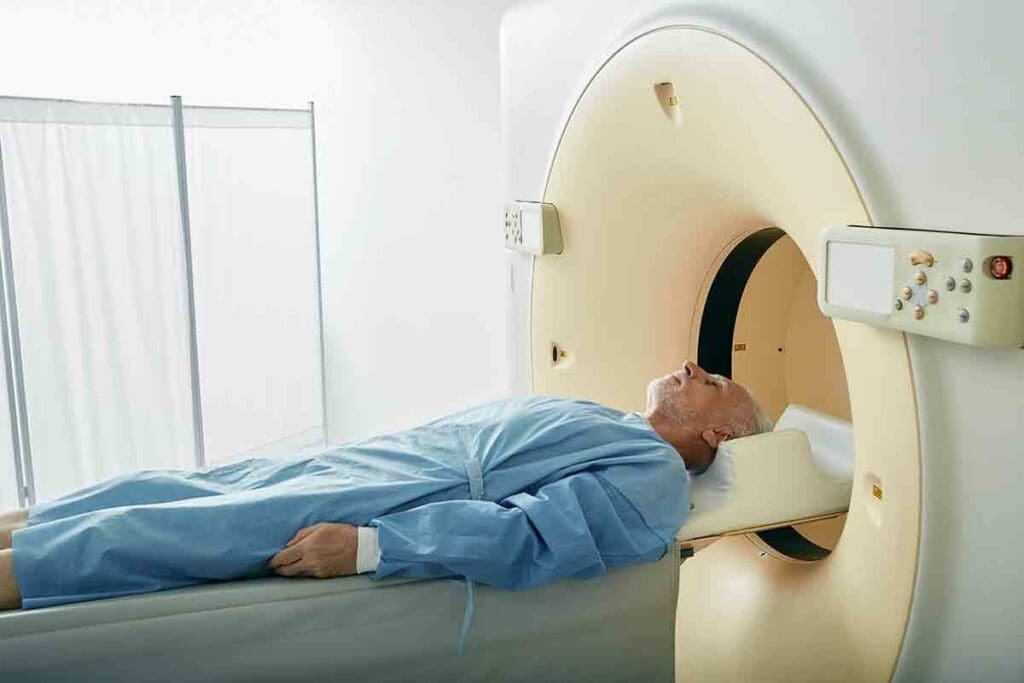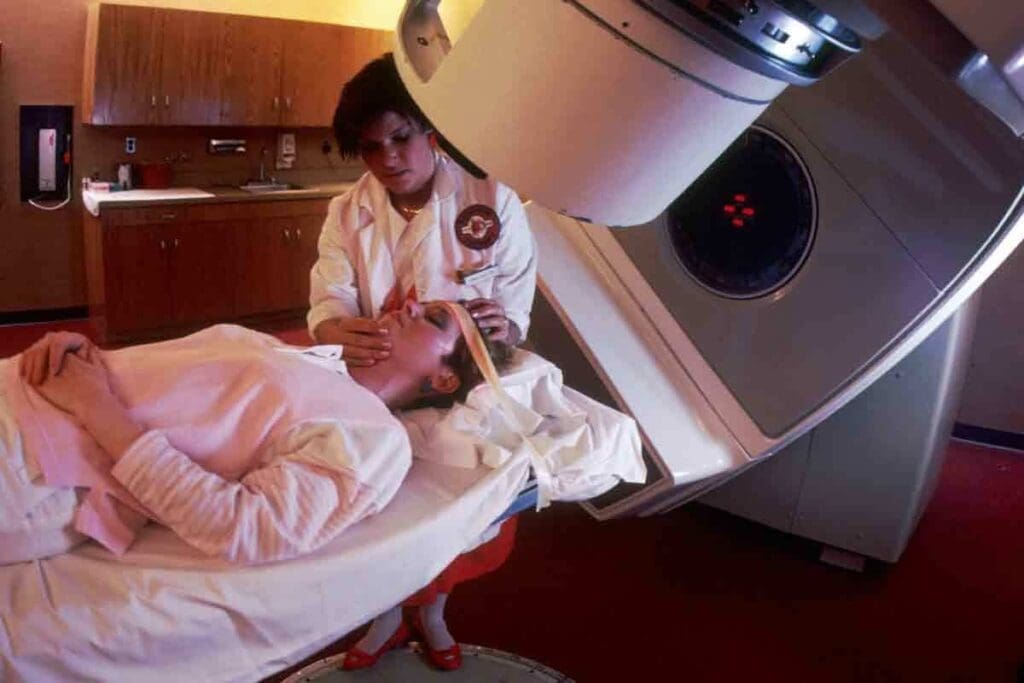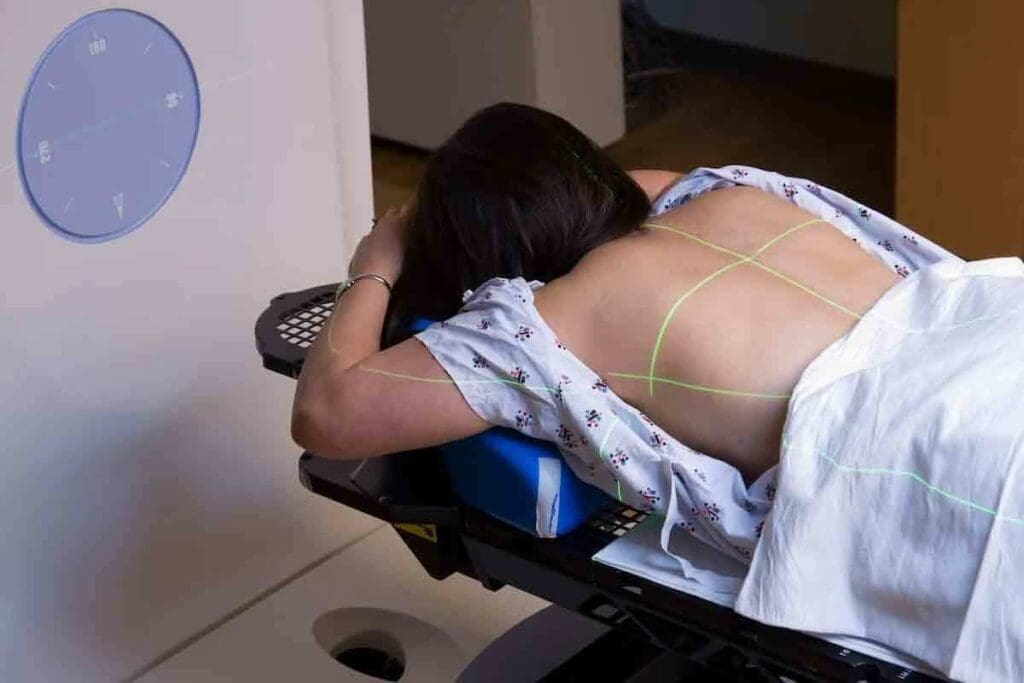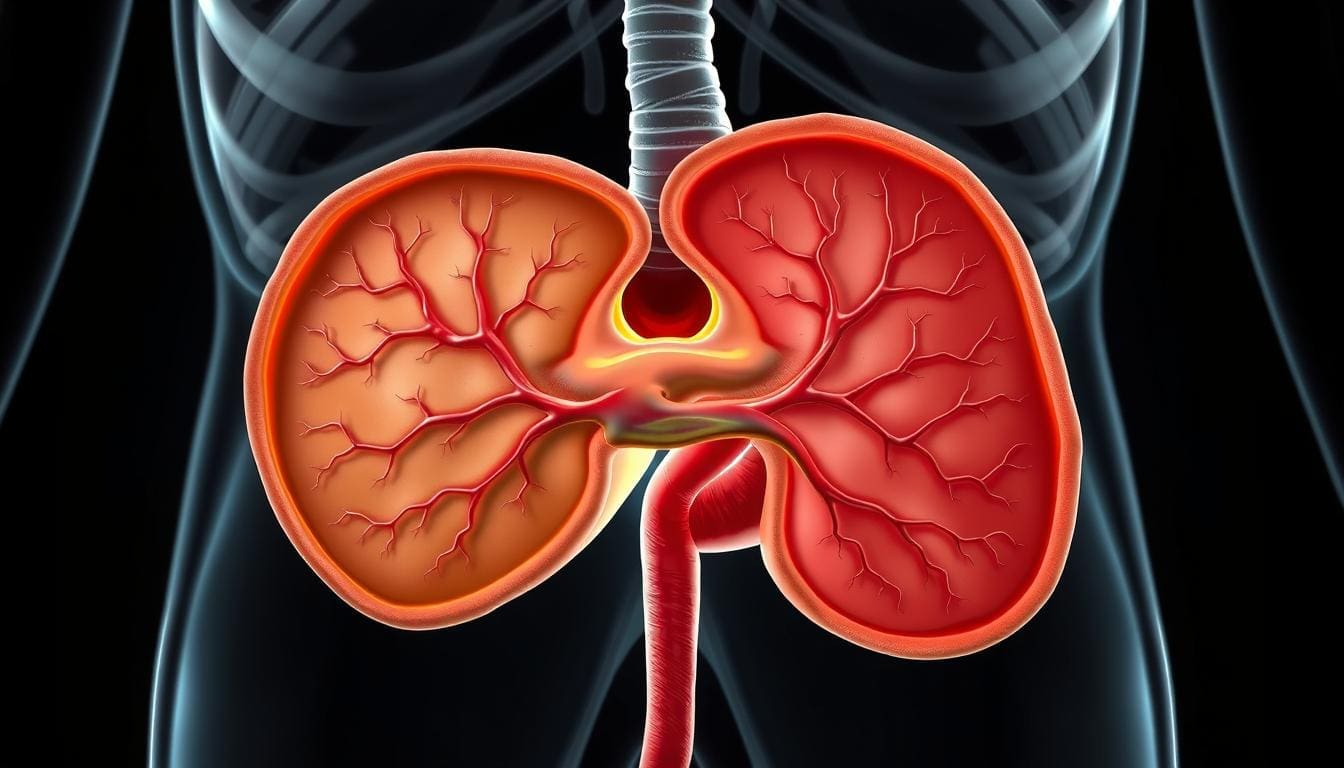Last Updated on November 27, 2025 by Bilal Hasdemir

At Liv Hospital, we know how vital precise and effective cancer therapy is. External beam therapy is key in modern cancer care. It uses advanced radiation machines to hit tumors without harming nearby healthy tissue. External beam radiation therapy is a local treatment for specific body parts. It’s used to treat many types of cancer.
We use the latest radiation treatment equipment for advanced external beam therapy. This offers hope and effective cancer therapy with care and precision. In this article, we’ll look at the top 7 radiation machines for cancer types used in external beam therapy.
Key Takeaways
- External beam therapy is a key part of modern cancer care.
- Advanced radiation machines target tumors while minimizing damage to healthy tissue.
- Liv Hospital uses the latest radiation treatment equipment for effective cancer therapy.
- External beam radiation therapy treats a specific part of the body.
- Many types of cancer can be treated with external beam therapy.
The Science Behind External Beam Radiation Therapy

Understanding external beam radiation therapy is key to its role in fighting cancer. It sends high-energy beams to tumors from outside the body. These beams come from machines like linear accelerators and can be different types of particles.
How External Beam Therapy Targets Cancer Cells
External beam therapy aims at cancer cells with precise radiation beams. This method helps protect healthy tissues nearby. Advanced imaging helps plan and deliver the radiation accurately.
The process includes several steps:
- Imaging tests to locate the tumor
- Creating a personalized treatment plan
- Delivering radiation beams from multiple angles
- Monitoring the treatment’s progress
Different Types of Radiation Beams: Photon, Proton, and Electron
There are three main types of radiation beams in external beam therapy: photons, protons, and electrons. Photon beams penetrate deep into tissues. Proton beams focus on the tumor with less damage to nearby tissues. Electron beams are best for shallow tumors.
Statistics on Radiotherapy Usage in Cancer Treatment
More than half of cancer patients get radiotherapy, including external beam therapy. This shows radiotherapy’s big role in cancer care. It can treat many cancers, alone or with surgery and chemotherapy.
Radiotherapy use changes with cancer type and stage. It’s often used for breast, prostate, and lung cancers. Having modern equipment and skilled staff is vital for cancer treatment.
Linear Accelerators (LINACs): The Cornerstone of Radiation Treatment Equipment

At the heart of radiation oncology lies the linear accelerator (LINAC). It’s a key tool for delivering precise radiation therapy. LINACs generate high-energy beams that target tumors effectively while protecting healthy tissues.
Generating and Directing Radiation
Linear accelerators create radiation beams by accelerating electrons to high energies. These electrons produce photon beams or hit the tumor site. The process includes several steps:
- Electron acceleration: Electrons are accelerated to high energies using microwave energy.
- Beam production: The accelerated electrons produce a photon beam or hit the target.
- Beam shaping: The radiation beam is shaped to fit the tumor’s shape.
Precision in radiation delivery is key to effective treatment. LINACs make this precision possible through advanced beam shaping and delivery.
Key Components and Technical Specifications
A typical LINAC has several key components, including:
| Component | Description |
| Electron Gun | Produces electrons that are accelerated to high energies. |
| Accelerating Structure | Where electrons are accelerated using microwave energy. |
| Beam Transport System | Directs the accelerated electrons or photon beam to the target. |
Modern LINACs have advanced technical specs, like high-dose rates and precise beam control. Experts say, “The development of LINACs has revolutionized radiation therapy, enabling the delivery of high doses to tumors with unprecedented precision.”
“The development of LINACs has revolutionized radiation therapy, enabling the delivery of high doses to tumors with unprecedented precision,”
a statement that highlights LINACs’ importance in modern radiation oncology.
Modern LINAC Features for Enhanced Precision
Modern LINACs have features that boost treatment precision, including:
- Advanced beam shaping technologies, such as multi-leaf collimators.
- Image-guided radiation therapy (IGRT) capabilities.
- Volumetric modulated arc therapy (VMAT) delivery.
These features allow us to deliver radiation therapy with unparalleled accuracy. This improves treatment outcomes for patients.
3D Conformal Radiation Therapy Systems
3D conformal radiation therapy has greatly improved treatment precision. It allows us to target tumors better while protecting healthy tissue.
Evolution from 2D to 3D Treatment Planning
The move from 2D to 3D planning is a big step forward. We use CT, MRI, and PET scans to create detailed 3D models. This helps plan and deliver radiation beams that fit the tumor’s shape.
Equipment Components for 3D Conformal Delivery
For 3D conformal radiation therapy, we use special equipment. Linear accelerators with advanced multileaf collimators shape the radiation beam around the tumor.
Shaping the radiation beam accurately is key to effective treatment. Advanced technology ensures the radiation dose hits the tumor site precisely.
Benefits for Tumor Targeting and Tissue Sparing
The benefits of 3D conformal radiation therapy are clear. It targets tumors well, delivering high doses of radiation while protecting healthy tissue. This results in better treatment outcomes and fewer side effects for patients.
Tumor targeting is much better with 3D conformal radiation therapy. It makes treatment more effective and reduces complications.
Intensity-Modulated Radiation Therapy (IMRT) Systems
Intensity-Modulated Radiation Therapy (IMRT) is a big step forward in treating cancer. It uses many small beams with different strengths to hit the tumor right on. This way, it protects the healthy tissue around it.
Advanced Beam Shaping Technology
IMRT systems have cool technology for shaping beams. This lets them change the beam’s strength in different parts. They use multi-leaf collimators (MLCs) to do this. These are thin leaves that move to shape the beam.
Hardware and Software Components of IMRT Equipment
IMRT systems have both hardware and software parts. The hardware includes machines that make high-energy beams, MLCs for shaping, and systems for checking patient position. The software helps plan the treatment by adjusting beam strength and shape.
- Linear accelerators for radiation delivery
- Multi-leaf collimators for beam shaping
- Imaging systems for patient positioning
- Advanced treatment planning software
Clinical Applications and Treatment Planning Process
IMRT helps treat many cancers,ike prostate, head and neck, and breast cancers. Planning treatment involves steps like getting the patient ready, imaging, and planning the dose. The aim is to give the tumor the right dose while protecting healthy tissues.
We use IMRT to make treatments better. It helps us give precise doses to tumors. This improves our patients’ quality of life.
Volumetric Modulated Arc Therapy (VMAT) Equipment
Volumetric Modulated Arc Therapy (VMAT) is a big step forward in radiation therapy. It allows for continuous radiation delivery, making treatments more efficient. We use VMAT to give precise doses to tumors while protecting healthy tissues.
Continuous Radiation Delivery Mechanism
VMAT machines send radiation in a continuous arc around the patient. This method is better than the old static beam therapy for treating complex tumors. It makes treatments more effective.
The arc delivery in VMAT improves treatment efficiency by cutting down treatment time. It also enhances precision with real-time adjustments during treatment.
Technical Specifications and Delivery Mechanisms
VMAT equipment has advanced beam modulation and precise gantry control systems. These features allow for complex radiation patterns that match the tumor’s shape closely.
- Advanced beam modulation technology
- High-precision gantry control systems
- Real-time imaging and feedback systems
These specs make VMAT treatments precise and efficient. It’s a key tool in our radiation therapy.
Comparison with Fixed-Beam IMRT Systems
VMAT and fixed-beam IMRT systems differ in how they deliver radiation. VMAT uses a continuous arc, while fixed-beam IMRT uses multiple fixed angles.
| Feature | VMAT | Fixed-Beam IMRT |
| Delivery Mechanism | Continuous Arc | Multiple Fixed Angles |
| Treatment Time | Generally Shorter | Variable, often longer |
| Conformality | Highly Conformal | Highly Conformal |
VMAT is faster and more efficient, making it a top choice for complex cases.
Stereotactic Radiosurgery (SRS) and Stereotactic Body Radiation Therapy (SBRT) Systems
SRS and SBRT are leading technologies in radiation oncology. They offer effective treatments for small tumors and lesions. These methods use precise imaging and tracking to target tumors accurately, reducing harm to healthy tissue.
Specialized Equipment for High-Precision Treatment
The success of SRS and SBRT relies on specialized equipment. This equipment is designed to deliver radiation with sub-millimeter accuracy. It uses advanced imaging like cone-beam CT and MRI for precise tumor targeting.
Key features of SRS and SBRT equipment include:
- High-resolution imaging capabilities
- Advanced tracking systems for real-time tumor monitoring
- Precise collimation systems for accurate beam delivery
- Robotic or gantry-based delivery systems for flexible treatment angles
Gamma Knife Technology for Intracranial Lesions
Gamma Knife radiosurgery is a specialized SRS for intracranial lesions. It uses a focused gamma radiation source for precise doses to brain areas.
The Gamma Knife system has many benefits, including:
- Extremely high precision, typically within 0.3 mm
- Non-invasive treatment, eliminating the need for surgical incisions
- Ability to treat complex or hard-to-reach intracranial targets
CyberKnife and Other Robotic Radiosurgery Systems
CyberKnife is a well-known robotic radiosurgery system for SRS and SBRT. It combines a LINAC with a robotic arm for flexible and precise radiation delivery.
The benefits of CyberKnife and similar systems include:
- Real-time tracking of tumor movement during treatment
- Ability to treat tumors in various locations throughout the body
- Highly conformal dose distributions, sparing surrounding healthy tissue
Proton Therapy Systems: The Cutting Edge of Radiation Treatment Equipment
Cancer treatment is getting better, thanks to proton therapy systems. They offer a big advantage by causing less damage to healthy tissue. We use proton beam therapy to give precise doses of radiation, thanks to the Bragg peak.
The Physics of Proton Beam Therapy and the Bragg Peak
Proton beam therapy uses protons to target tumors. The Bragg peak lets protons release most of their energy at a specific depth. This means we can hit the tumor right on, while keeping healthy tissue safe.
The Bragg peak is key to proton therapy’s success. By changing the proton beam’s energy, we control where the Bragg peak happens. This ensures the tumor gets the most dose, while avoiding healthy tissue.
Components of a Proton Therapy Center
A proton therapy center has several important parts. These include a particle accelerator, a beam transport system, and treatment rooms. The particle accelerator, like a cyclotron or synchrotron, gets protons to the right energy.
The beam transport system guides the proton beam to the treatment room. There, it’s delivered to the patient. Treatment rooms have advanced imaging and positioning systems for accurate delivery.
Cyclotrons vs. Synchrotrons: Particle Acceleration Methods
Proton therapy centers use cyclotrons or synchrotrons to speed up protons. Cyclotrons are more common because they’re compact and reliable. They use a constant magnetic field to accelerate protons in a circular orbit.
Synchrotrons can reach higher energies and offer more flexibility. But they’re bigger and more complex than cyclotrons.
Clinical Applications and Unique Advantages
Proton therapy is great for tumors near important structures, like brain or spinal tumors. It’s also good for kids with cancer. The precision of proton therapy means high doses for the tumor, with less harm to healthy tissue.
Proton therapy has unique benefits, like a lower risk of secondary cancers and less damage to tissues. It also leads to better treatment results for some tumors. As technology gets better, we’ll see even more uses for proton therapy.
Image-Guided Radiation Therapy (IGRT) Equipment
IGRT is a big step forward in radiation oncology. It lets doctors see tumors in real-time during treatment. This makes treatments more accurate and safer for healthy tissues.
On-Board Imaging Technologies
On-board imaging is key to IGRT. It lets doctors check the tumor’s position right before and during treatment. They use kV and MV imaging to get clear pictures of the tumor and nearby areas.
Thanks to on-board imaging, doctors can adjust treatment plans as needed. This ensures the radiation hits the tumor exactly right.
Cone Beam CT and MRI-Guided Systems
Cone Beam CT (CBCT) and MRI-guided systems are top-notch in IGRT. CBCT gives a 3D view of the tumor and tissues around it. This helps doctors pinpoint the treatment area with great accuracy.
MRI-guided systems offer even better detail, thanks to their soft-tissue contrast. This is super helpful for tumors in tricky spots.
Real-Time Tumor Tracking and Adaptive Radiotherapy
Real-time tumor tracking is a big part of IGRT. It lets doctors watch the tumor move during treatment. This info helps them tweak the treatment plan to hit the tumor just right.
Adaptive radiotherapy goes further. It changes the treatment plan if the tumor or patient anatomy changes. This way, doctors can adapt to any changes, making treatment even better.
Selecting the Right Radiation Treatment Equipment for Cancer Care
Choosing the right radiation treatment equipment is key to effective cancer care. It requires careful thought about many factors. As cancer treatment evolves, picking the right equipment is more important than ever.
Factors Influencing Equipment Selection
Many things affect the choice of radiation treatment equipment. These include the cancer type and stage, patient needs, and what resources are available. For example, Linear Accelerators (LINACs) are used for many cancers because they are versatile. On the other hand, Proton Therapy Systems are chosen for complex cases because they are very precise.
| Factor | Influence on Equipment Selection |
| Type and Stage of Cancer | Determines the complexity and precision required in treatment |
| Patient-Specific Factors | Affects the choice between different radiation modalities |
| Institutional Resources | Influences the availability and maintenance of equipment |
Cost Considerations and Facility Requirements
Cost is a big factor in choosing radiation treatment equipment. The cost to buy, maintain, and run the equipment varies a lot. For example, Proton Therapy Systems are very expensive because of their advanced technology.
“The cost of radiation therapy equipment is not just a financial consideration but also impacts the accessibility of care for patients.”
What the facility needs is also important. The space required, shielding needs, and training for staff are all key factors.
Treatment Outcomes and Patient Experience
The main goal of radiation treatment is to get the best results and improve the patient’s experience. The equipment used can greatly affect this. For example, Image-Guided Radiation Therapy (IGRT) lets doctors make adjustments in real-time, improving accuracy.
Emerging Hybrid Technologies
New hybrid technologies are coming into radiation oncology. These combine different radiation types. They promise to make treatments more precise and effective. For example, MR-LINAC technology adds MRI guidance to radiation delivery in real-time.
As we keep improving cancer care, choosing the right radiation equipment will be even more important. It will be influenced by cost, what the facility needs, and the desire for better treatment results.
Conclusion: Advancing Cancer Care Through Radiation Technology
Radiation technology keeps getting better, opening up new ways to fight cancer. New tools like Intensity-Modulated Radiation Therapy (IMRT) and Volumetric Modulated Arc Therapy (VMAT) are making treatments more precise. This means better care for patients.
We’ve looked at the top 7 types of radiation equipment used today. Each one has special features and uses. As technology grows, we’re ready to offer the best treatments to cancer patients. This way, we can make cancer care even better and help more people.
FAQ
What is external beam radiation therapy?
External beam radiation therapy is a cancer treatment. It uses high-energy beams from outside the body. These beams target and destroy cancer cells.
How does linear accelerator (LINAC) technology work in radiation treatment?
LINACs create and direct radiation beams to tumors. This technology offers precision and flexibility in treatment.
What is the difference between 2D and 3D conformal radiation therapy?
3D conformal therapy is more advanced than 2D. It targets tumors more precisely and harms less healthy tissue.
What is intensity-modulated radiation therapy (IMRT)?
IMRT is a precise radiation therapy. It changes the intensity of beams for better treatment.
How does volumetric modulated arc therapy (VMAT) differ from fixed-beam IMRT?
VMAT uses a continuous arc around the patient. It’s different from fixed-beam IMRT systems.
What are stereotactic radiosurgery (SRS) and stereotactic body radiation therapy (SBRT)?
SRS and SBRT are precise treatments for small tumors. They use special equipment like Gamma Knife technology.
What are the advantages of proton therapy in radiation treatment?
Proton therapy reduces damage to healthy tissue. This is due to its unique physics and the Bragg peak.
What is image-guided radiation therapy (IGRT)?
IGRT is key in modern radiation treatment. It uses imaging to track tumors in real-time.
What factors influence the selection of radiation treatment equipment?
Choosing radiation equipment depends on cost, facility needs, treatment results, and new technologies.
What is the role of radiation treatment equipment in modern cancer care?
Radiation equipment is vital in cancer care. Advances in technology improve treatment outcomes and patient care.
What is beam radiation therapy?
Beam radiation therapy, or external beam radiation therapy, targets cancer cells with high-energy beams from outside the body.
What is the difference between a cyclotron and a synchrotron in proton therapy?
Cyclotrons and synchrotrons accelerate particles in proton therapy. They differ in technical details and delivery.
Reference:
PubMed Central. (2024). MR-LINAC, a new partner in radiation oncology: Current landscape. https://pmc.ncbi.nlm.nih.gov/articles/PMC10813892






